Queenright ... or not?
A brief follow-up to the (ridiculously long) post last week about leaving queen cells in the colony after a) it swarms, or b) implementing swarm control {{1}}.
How long does it take for the new queen to emerge, mate and start laying?
And what if she doesn’t?
How did we get here?
We are approaching the peak of the beekeeping season. Colonies have built up strongly and should now be topped by comfortingly heavy supers of spring honey.
Mind your back 😯
The box you inspected in early April and found three frames of brood in is now bursting at the seams with bees and brood. Everything is getting busier and bigger. You may have already run out of supers or – lucky you – are frantically extracting to free-up supers to return to the colonies.
Depending upon your location you may already have discovered that your swarm prevention efforts, whilst temporarily effective, were soon treated with disdain as the colonies started to build queen cells.
You are now using some form of swarm control and the colony now contains a mature queen cell.
Or they swarmed … leaving a mature queen cell 🙁
Queenless colonies
Is a colony with a charged, capped, queen cell queenless?
A philosophical question 🙂
I guess the answer is technically no, but practically yes.
There’s clearly a queen in the hive, but she’s really a potential queen. To be useful to the colony (and the beekeeper) she has to emerge, mature, mate and start laying.
It’s at that stage that the colony can be described as queenright.
All of this takes time and all of which significantly changes the tempo of the season.
Colonies that are requeening should generally not be disturbed and the change from full-on to full-off can feel strange.
Doubly so, because the lack of reassuring inspections can make the wait seem interminable.
It’s tempting to have a quick peek … after all, what harm could it do?
Tick tock
The development of a queen takes 16 days from egg to eclosed virgin. The first three days as an egg, then six days as a larva before a further week as a developing pupa. The rapid development is due to the very rich diet that queens are fed in the first couple of days. This triggers a host of changes in gene expression {{2}} which dramatically alters the morphology, behaviour and longevity of the queen from the genetically identical worker.
After a virgin queen emerges she needs to mature sexually which takes 5-6 days. During this period they don’t look or behave much like queens. They tend to be quite small and, if disturbed, rush about the frame skittishly. They are also a lot more willing to fly than a mature laying queen – you have been warned! {{3}}

What a beauty
Virgin queens are not lavished with attention by a retinue of workers, all of which often makes them more difficult to find in the hive.
The queen goes on one or more mating flights which usually take place on warm, calm, sunny early afternoons.
She then returns to the hive and, 2-3 days later, starts laying eggs. A queen that has just started laying sometimes lays more than one egg per cell. However, she settles down fast and will usually lay in a reasonably tight pattern in the centre of one of the middle frames in the brood nest.
Have patience
Add all those timings up and you have a minimum of two weeks between the capping of the queen cell and the day when she starts laying.
To be sure, you need to know when the queen cell was capped which is difficult if you’re dealing with a colony that swarmed. Was the cell capped on the day the colony swarmed (not unusual), or was it capped during the lousy weather a few days earlier that then delayed the emergence of the swarm?
It is unwise to disturb a virgin queen.
All sorts of things can go wrong. You might inadvertently crush her during an inspection {{4}} or scare her into taking flight and getting lost in the long grass.
Equally calamitous would be inspecting the colony on the nice, calm, warm mid-afternoon when she decides to go off on her mating flight. She’ll be off consorting with the local drones for about 10 – 30 minutes, and may go on more than one flight on subsequent days. If she returns to find the roof and supers off, the brood frames out and smoke being puffed everywhere she may never find the hive entrance.
None of the above ends well.
Minima and maxima
The two weeks detailed above is the absolute minimum. I don’t check these things routinely but think the only time I’ve really seen it taking that short a period (from cell sealing to a mated laying queen) is when queen rearing using mini-mating nucs.
Queens tend to get mated in these very fast if the weather is suitable. I don’t know why {{5}}.
But, if the weather is unsuitable, irrespective of the hive type, mating will be delayed.
By ‘unsuitable’ I mean lousy. If it’s raining persistently or blowing a hoolie the queen will not venture forth.
If it’s cool (16 – 18°C) and cloudy she might, particularly if she’s of the darker Apis mellifera mellifera strain.
But then again, she might not 🙁
All of which means that the two weeks quoted really is a minimum.
What if it rains for a month? The virgin queen has a ‘shelf life’. If she does not get mated within ~26-33 days of emergence she is unlikely to get successfully mated at all.
To summarise, it will take a minimum of two weeks from queen cell capping to having a laying queen in the hive. If 40 days elapse before the queen is mated (again from cell capping) it is likely that she will be a dud.
Three weeks
Assuming the weather has been OK for queen mating I usually leave a minimum of three weeks between closing the hive up with a capped queen cell and looking for the mated queen.
There’s little to be gained by rummaging around the hive before then … and a whole lot to be potentially lost.
If you do open the hive up too early – assuming none of the nightmare scenarios above occur – what can you expect to see?
Lift the dummy board out, prise out the last frame and then split the hive somewhere in the middle of the remaining frames i.e. don’t work through frame by frame, this isn’t a routine inspection, it’s a Royal Checkup.
If you look around the middle of the face of the central frames you can often see polished cells. These have been cleaned and prepared by the workers for the queen to lay in. They’re particularly obvious if the comb is a bit old and dark – then they really do look polished and shiny.
If there are polished cells present, but no eggs, I’m then reasonably confident that there’s a queen in the hive but that she’s not started laying yet (but is probably mated).
There’s no point in looking for her. Close the hive up and leave it another week.
If she is laying, leave her be. Wait until she’s laid up a few frames and you can tell she has a good laying pattern of worker brood i.e. look at the appearance of the sealed brood, then find her and mark her {{6}}.
Breathe a sigh of relief … your colony is again queenright.
Five weeks
If five weeks {{7}} have elapsed between leaving a freshly capped cell in the hive and the non-appearance of eggs I start to fear the worst.
The colony will now have no brood – it all emerged about two and half weeks ago – and the lack of brood pheromone means there’s a possibility that the colony will develop laying workers.
There may be a queen present, but she’s rapidly becoming an ageing spinster.
In this situation it is probably wise to decide what Plan B is … how will you ‘rescue’ the colony?
If you leave the colony for another week or fortnight you might find a laying queen, but you probably won’t. During this period the colony will dwindle further in size and strength {{8}}.
Plan B
You effectively have four choices:
- Unite the colony with a known queenright colony.
- Requeen the colony with a mated, laying queen {{9}}.
- Add a mature capped queen cell to the colony. Start nervously pacing the apiary again waiting for her to emerge, mature, mate and start laying.
- Allow the colony to rear their own queen by providing a frame of eggs (see below).
It is important to find and dispatch the ‘failed’ queen if you are going to do 1, 2 or 3. The queen may have failed to get mated but she might still be able to kill a challenger queen in the hive.
Uniting the colony is often the best and safest option. It’s quick. It uses the bees remaining in the colony immediately and it strengthens another hive. It’s my preferred option … but I have quite a few colonies to work with. If you have just one (and you shouldn’t have) it’s clearly a non-starter.
Adding an expensive purchased mated laying queen (or a cheap one) can be risky. Terminally queenless and broodless colonies are often tricky to requeen. The most successful way I’ve found to do this {{10}} is to use a large cage pinned over a frame of emerging brood. And even then it doesn’t always work 🙁
If you already have laying workers it is not worth trying to requeen the colony – they’ll almost certainly kill her. I usually try once to ‘rescue’ a laying worker hive (details here), but then shake them out.
Adding a capped queen cells can work if the colony is queenless but you will have another long wait ahead of you … and all the time the colony is dwindling in size.
She emerges into a population of geriatric workers. Far from ideal.
But what if you can’t find the queen?
Is the colony really queenless?
Perhaps she mated quite late because of poor weather and is about to get started?
Perhaps she failed to mate and is just lurking in there waiting to slaughter the £40 Buckfast queen you’re about to add 🙁
Frame of eggs
Most of these questions can be answered by adding a ‘frame of eggs’.
A queenless colony will start to rear a new queen if presented with eggs and larvae.
A queenright colony will not.
If you are unsure whether a colony is queenright add a frame containing a good number of eggs. I usually like to use a full brood frame also containing some larvae and sealed brood. The brood pheromone will help hold back laying worker development. The new young bees that emerge will bolster the hive population and will be there to help the new queen when she returns from getting mated.
If you have the luxury of choosing a frame of eggs on relatively new fresh comb the bees will find it easier to draw queen cells. However, don’t worry if you don’t … if they’re queenless they’ll be thankful for anything.
Check the colony a few days after adding the frame of eggs. If they’ve started queen cells {{11}} then I just let them get on with it and check again in about a month or so for a laying queen. They won’t swarm or generate casts as – by this time – bee numbers are significantly depleted.
However, if they don’t start queen cells it means there’s a queen somewhere in the hive. Check the other frames in the hive for eggs. It’s not at all unusual to find the original queen has now started laying. Again, leave her to get on with it.
But if there are no eggs on other frames and no queen cells (on the frame you added) you need to find the non-functioning queen … and we’ll deal with that sometime in the future 😉
Good luck
Colophon
The usual dictionary definition of queenright just references a colony of bees that contains a queen. The OED has references going back to 1911 (When a colony is found that is not queen-right, it is remorselessly broken up, and distributed among other colonies, or united with a weak colony having a good queen, C.C. Miller in Fifty Years among Bees) including some from Wedmore and E.O Wilson.
However, none specifically state whether the queen is laying. Or what she’s laying. A queenless colony is easy to define. But what about a colony containing a virgin queen? Or a drone laying queen?
I’d argue that in these situations the colony contains a queen, but things aren’t really ‘right’ (as in correct). In my view, queenright means a mated, laying queen.
Please, no pedantic questions or comments about a colony containing a well mated queen that, because there’s a nectar dearth, has stopped laying … 😉
{{1}}: My definition of swarm control here includes anything that leaves the colony without a queen …
{{2}}: For example, see Jay Evans’ paper Evans JD & Wheeler DE. Differential gene expression between developing queens and workers in the honey bee, Apis mellifera. Proc Natl Acad Sci U S A. 1999 ; 96:5575‐5580 or, more recently, Yin et al., (2018) Uncovering the Changing Gene Expression Profile of Honeybee (Apis mellifera) Worker Larvae Transplanted to Queen Cells. Frontiers in Genetics https://doi.org/10.3389/fgene.2018.00416.
{{3}}: Like workers, queens go on orientation flights before leaving the hive on a mating flight. If spooked into flight (by a clumsy inspection) before she knows where the hive is you might lose her.
{{4}}: Obviously there’s no need to inspect the colony when it’s requeening. Check the supers aren’t full but leave the brood box alone.
{{5}}: There seems to be a direct relationship between hive size and the speed with which a queen gets mated. Mini-nucs are very fast, 5 frame nucs next and full-sized colonies the slowest of all, at least in my experience.
{{6}}: It’s easier to find a queen at this stage because a) she has settled down and is calmly walking about on the frames and b) there are fewer bees in the hive – the older bees have been dying off and the new brood from the new queen has yet to emerge. Of course, if she’s not laying worker brood your problems have only just started …
{{7}}: i.e. four weeks since the queen emerged.
{{8}}: The longer you leave things the worse the situation gets.
{{9}}: Presumably purchased – or a gift. If you actively rear your own queens you would have probably saved all this faffing around by plonking a new queen into the hive a month ago … a compelling reason to rear your own queens.
{{10}}: Which deserves a full post.
{{11}}: You only need to check the frame you added for queen cells.
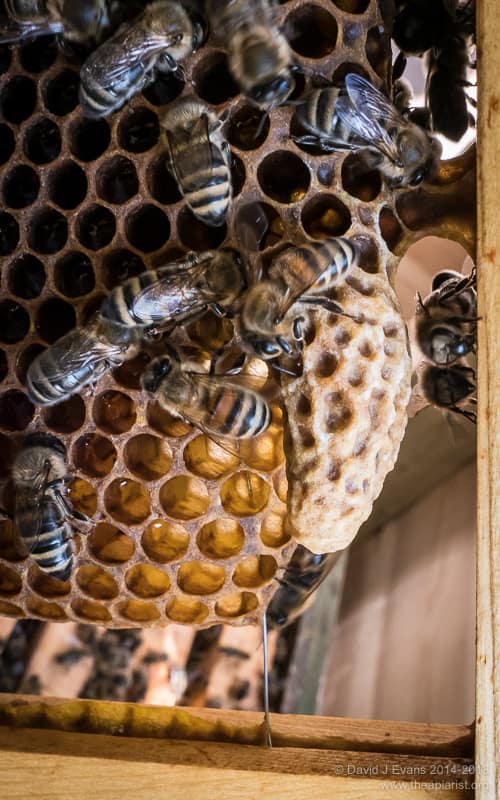
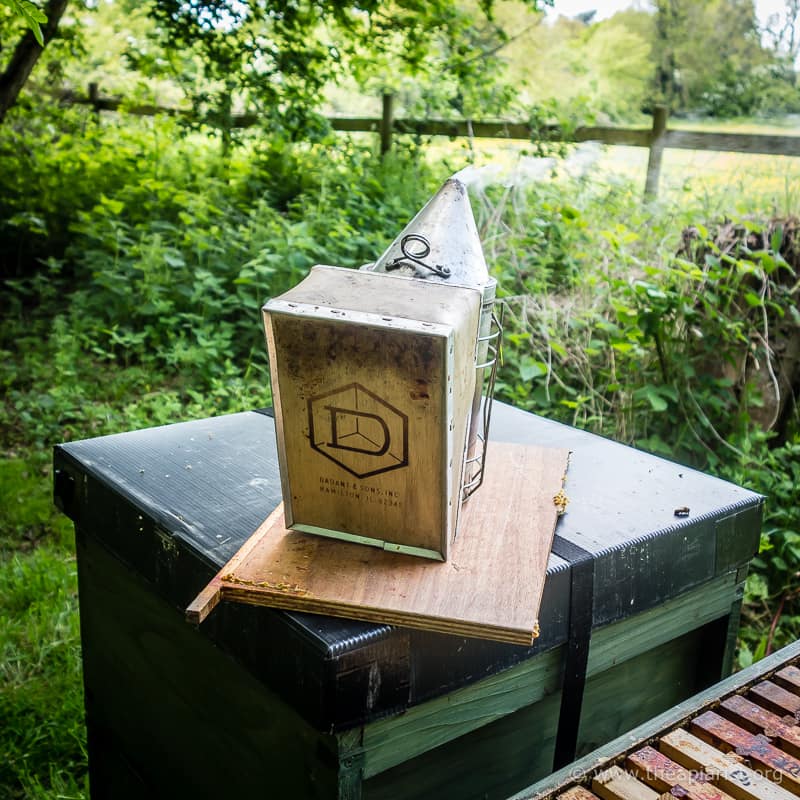
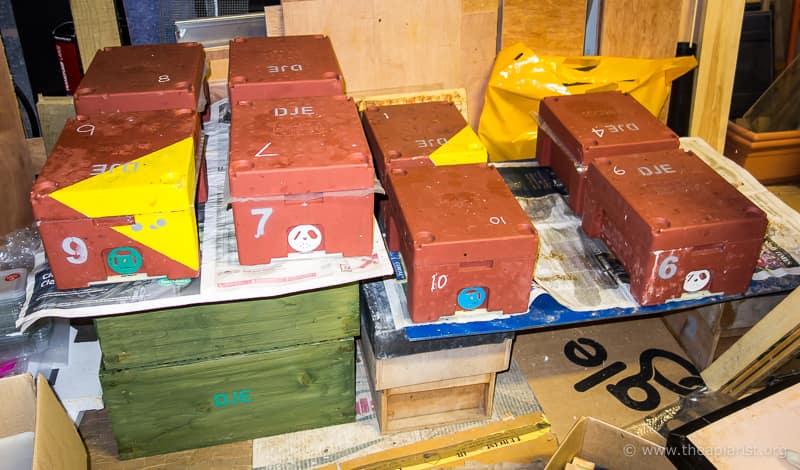

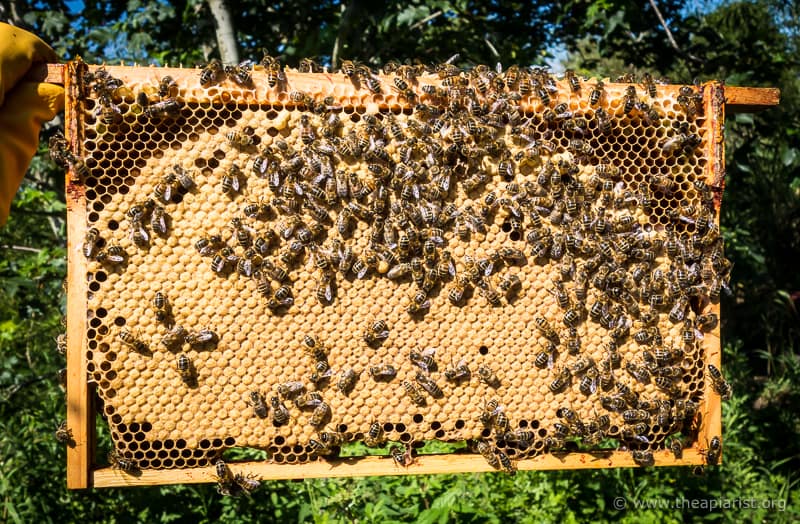
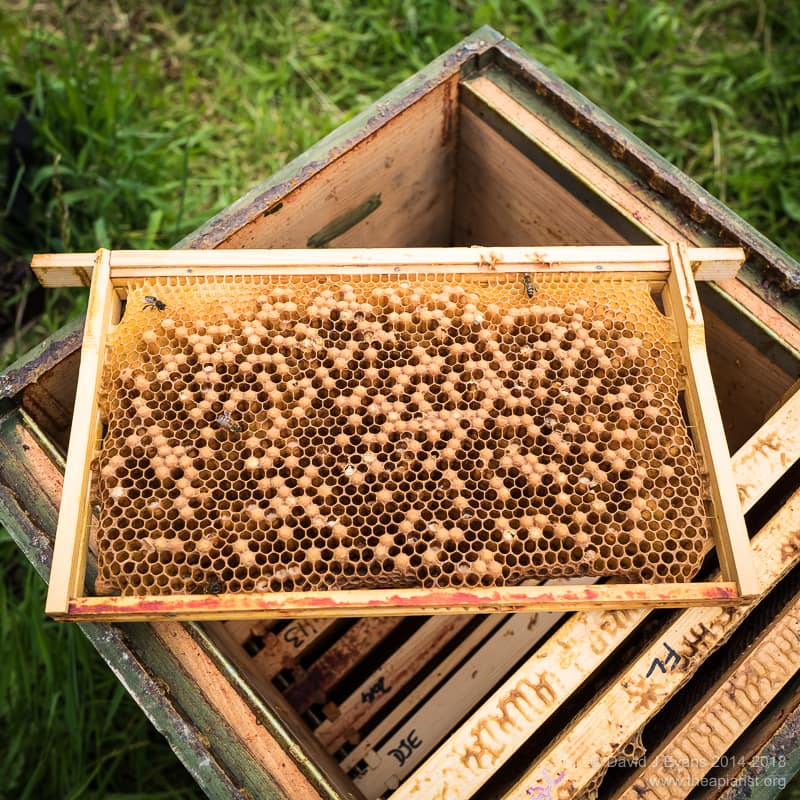
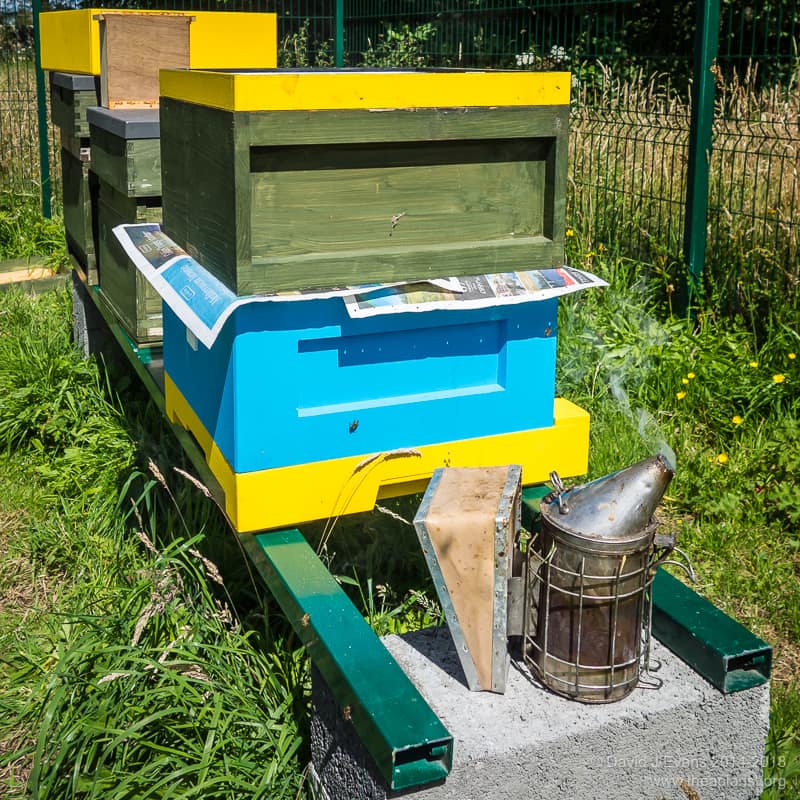
Join the discussion ...